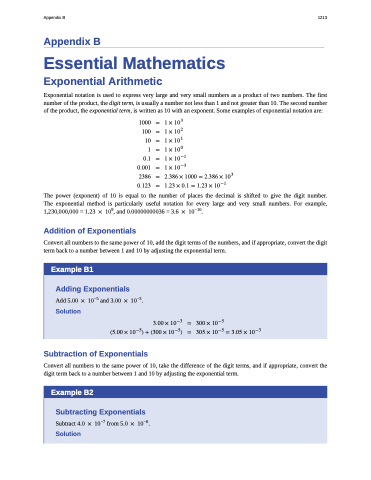Page 1223 - Chemistry--atom first
P. 1223
Appendix B 1213
Appendix B
Essential Mathematics Exponential Arithmetic
Exponential notation is used to express very large and very small numbers as a product of two numbers. The first number of the product, the digit term, is usually a number not less than 1 and not greater than 10. The second number of the product, the exponential term, is written as 10 with an exponent. Some examples of exponential notation are:
���� � ��� � �� � � � ��� � ����� � ���� � ����� �
�����
�����
�����
�����
������
������
����� � ���� � ����� � ��� ������������������
The power (exponent) of 10 is equal to the number of places the decimal is shifted to give the digit number. The exponential method is particularly useful notation for every large and very small numbers. For example, 1,230,000,000 = 1.23 � 109, and 0.00000000036 = 3.6 � 10−10.
Addition of Exponentials
Convert all numbers to the same power of 10, add the digit terms of the numbers, and if appropriate, convert the digit term back to a number between 1 and 10 by adjusting the exponential term.
Example B1
Adding Exponentials
Add 5.00 � 10−5 and 3.00 � 10−3. Solution
���� � ���� � ��� � ���� ���������������������� � �������� ����������
Subtraction of Exponentials
Convert all numbers to the same power of 10, take the difference of the digit terms, and if appropriate, convert the digit term back to a number between 1 and 10 by adjusting the exponential term.
Example B2
Subtracting Exponentials
Subtract 4.0 � 10−7 from 5.0 � 10−6. Solution


